Influence of CA-Modified Hβ on Methane-Assisted Hydroconversion of Polycyclic Aromatics to Monocyclic Aromatics
Abstract
1. Introduction
2. Materials and Methods
2.1. Materials
2.2. Preparation of Catalysts
2.3. Catalyst Characterization
2.4. Catalyst Performance Evaluation
3. Results and Discussions
3.1. Characterization of Zn/Hβ Catalysts Treated with Different Concentrations of CA
3.1.1. The XRD Analysis
3.1.2. Nitrogen Adsorption–Desorption
3.1.3. The NH3-TPD Analysis
3.1.4. The Pyridine Infrared Characterization
3.2. Catalytic Performance of the Zn/Hβ Catalysts from Different Concentrations of CA
4. Conclusions
Author Contributions
Funding
Data Availability Statement
Conflicts of Interest
References
- Li, Z.; Li, Y.; Xu, H.; Jarvis, J.; Meng, S.; Song, H. Effect of methane presence on catalytic heavy oil partial upgrading. Fuel 2021, 297, 120733. [Google Scholar] [CrossRef]
- Choudhary, V.R.; Kinage, A.K.; Choudhary, T.V. Low-temperature nonoxidative activation of methane over H-galloaluminosilicate (MFI) zeolite. Science 1997, 275, 1286–1288. [Google Scholar] [CrossRef]
- He, P.; Song, H. Catalytic conversion of biomass by natural gas for oil quality upgrading. Ind. Eng. Chem. Res. 2014, 53, 15862–15870. [Google Scholar] [CrossRef]
- He, P.; Luan, Y.; Zhao, L.; Cheng, W.; Wu, C.; Chen, S.; Song, H. Catalytic bitumen partial upgrading over Ag-Ga/ZSM-5 under methane environment. Fuel Process. Technol. 2017, 156, 290–297. [Google Scholar] [CrossRef]
- Shen, Z.; He, P.; Wang, A.; Harrhy, J.; Meng, S.; Peng, H.; Song, H. Conversion of naphthalene as model compound of polyaromatics to mono-aromatic hydrocarbons under the mixed hydrogen and methane atmosphere. Fuel 2019, 243, 469–477. [Google Scholar] [CrossRef]
- Shen, Z.; Fu, R.; Zhang, S.; Wang, S.; Wu, Z.; Tang, R.; Liang, S.; Zhang, J.; Yuan, S.; Jiang, H. Selective Hydrogenation of Polycyclic Aromatics to Monocyclic Aromatics over NiMoC/H beta Catalysts in a Methane and Hydrogen Environment. China Pet. Process. Petrochem. Technol. 2023, 25, 92–100. [Google Scholar]
- Wei, Q.; Zhang, J.; Liu, X.; Zhang, P.; Wang, S.; Wang, Y.; Zhang, Z.; Zhang, T.; Zhou, Y. Citric acid-treated zeolite Y (CY)/Zeolite beta composites as supports for vacuum gas oil hydrocracking catalysts: High yield production of highly-aromatic heavy naphtha and low-BMCI value tail oil. Front. Chem. 2019, 7, 705. [Google Scholar] [CrossRef]
- Wang, B.; Yan, X.; Zhang, X.; Zhang, H.; Li, F. Citric acid-modified beta zeolite for polyoxymethylene dimethyl ethers synthesis: The textural and acidic properties regulation. Appl. Catal. B Environ. 2020, 266, 118645. [Google Scholar] [CrossRef]
- Brunauer, S.; Emmet, P.H.; Teller, E. Adsorption of gases in multimolecular layers. J. Am. Chem. Soc. 1938, 60, 309–319. [Google Scholar] [CrossRef]
- Barrett, E.P.; Joyner, L.G.; Halenda, P.P. The Determination of Pore Volume and Area Distributions in Porous Substances. I. Computations from Nitrogen Isotherms. J. Am. Chem. Soc. 1951, 73, 373–380. [Google Scholar] [CrossRef]
- Bukhtiyarova, M.V.; Toktarev, A.V.; Kazakov, M.O.; Kodenev, E.G.; Pereyma, V.Y.; Gabrienko, A.A.; Bukhtiyarov, A.V.; Echevsky, G.V. Effect of sulfosalicylic acid treatment on the properties of Beta zeolite and performance of NiW/Beta-based catalysts in hexadecane hydrocracking. Appl. Catal. A Gen. 2020, 598, 117573. [Google Scholar] [CrossRef]
- Zhu, M.; Muhammad, Y.; Hu, P.; Wang, B.; Wu, Y.; Sun, X.; Tong, Z.; Zhao, Z. Enhanced interfacial contact of dopamine bridged melamine-graphene/TiO2 nano-capsules for efficient photocatalytic degradation of gaseous formaldehyde. Appl. Catal. B Environ. 2018, 232, 182–193. [Google Scholar] [CrossRef]
- Imai, H.; Abe, M.; Terasaka, K.; Yamazaki, H.; Osuga, R.; Kondo, J.N.; Yokoi, T. Hydroconversion of methyl laurate over beta-zeolite-supported Ni–Mo catalysts: Effect of acid and base treatments of beta zeolite. Fuel Process. Technol. 2020, 197, 106182. [Google Scholar] [CrossRef]
- Halgeri, A.B.; Das, J. Recent advances in selectivation of zeolites for para-disubstituted aromatics. Catal. Today 2002, 73, 65–73. [Google Scholar] [CrossRef]
- Feng, C.; Huang, T.; Chen, H.M.; Yang, J.H.; Zhang, N.; Wang, Y.; Zhang, C.L.; Zhou, Z.W. Carbon nanotubes induced poly (vinylidene fluoride) crystallization from a miscible poly (vinylidene fluoride)/poly (methyl methacrylate) blend. Colloid Polym. Sci. 2014, 292, 3279–3290. [Google Scholar] [CrossRef]
- Bai, G.; Ma, Z.; Shi, L.; Lan, X.; Wang, Y.; Han, J.; Qiu, M.; Fu, H.; Liu, P. Continuous synthesis of bis (indolyl) phenylmethane over acid modified Hβ zeolite. Appl. Catal. A Gen. 2012, 427, 114–118. [Google Scholar] [CrossRef]
- Ateş, A.; Ozkan, I.; Canbaz, G.T. Role of modification of natural zeolite in removal of arsenic from aqueous solutions. Acta Chim. Slov. 2018, 65, 586–598. [Google Scholar] [CrossRef]
- Gac, W.; Greluk, M.; Słowik, G.; Millot, Y.; Valentin, L.; Dzwigaj, S. Effects of dealumination on the performance of Ni-containing BEA catalysts in bioethanol steam reforming. Appl. Catal. B Environ. 2018, 237, 94–109. [Google Scholar] [CrossRef]
- He, P.; Gatip, R.; Yung, M.; Zeng, H.; Song, H. Co-aromatization of olefin and methane over Ag-Ga/ZSM-5 catalyst at low temperature. Appl. Catal. B Environ. 2017, 211, 275–288. [Google Scholar] [CrossRef]
- de Lucas, A.; Ramos, M.J.; Dorado, F.; Sánchez, P.; Valverde, J.L. Influence of the Si/Al ratio in the hydroisomerization of n-octane over platinum and palladium beta zeolite-based catalysts with or without binder. Appl. Catal. A Gen. 2005, 289, 205–213. [Google Scholar] [CrossRef]
- Barzetti, T.; Selli, E.; Moscotti, D.; Forni, L. Pyridine and ammonia as probes for FTIR analysis of solid acid catalysts. J. Chem. Soc. Faraday Trans. 1996, 92, 1401–1407. [Google Scholar] [CrossRef]
- Austin, D.; Wang, A.; He, P.; Qian, H.; Zeng, H.; Song, H. Catalytic valorization of biomass derived glycerol under methane: Effect of catalyst synthesis method. Fuel 2018, 216, 218–226. [Google Scholar] [CrossRef]
- Garbarino, G.; Vijayakumar, R.P.P.; Riani, P.; Finocchio, E.; Busca, G. Ethanol and diethyl ether catalytic conversion over commercial alumina and lanthanum-doped alumina: Reaction paths, catalyst structure and coking. Appl. Catal. B Environ. 2018, 236, 490–500. [Google Scholar] [CrossRef]
- Wang, C.; Leng, S.; Guo, H.; Cao, L.; Huang, J. Acid and alkali treatments for regulation of hydrophilicity/hydrophobicity of natural zeolite. Appl. Surf. Sci. 2019, 478, 319–326. [Google Scholar] [CrossRef]
- Wang, A.; Austin, D.; Qian, H.; Zeng, H.; Song, H. Catalytic valorization of furfural under methane environment. ACS Sustain. Chem. Eng. 2018, 6, 8891–8903. [Google Scholar] [CrossRef]
- Anis, S.F.; Singaravel, G.; Hashaikeh, R. Hierarchical nano zeolite-Y hydrocracking composite fibers with highly efficient hydrocracking capability. RSC Adv. 2018, 8, 16703–16715. [Google Scholar] [CrossRef] [PubMed]
- Xu, H.; Li, Z.; Pryde, R.L.; Li, Y.; Song, H. Participation of methane in an economically and environmentally favorable catalytic asphaltene upgrading process. Chem. Commun. 2020, 56, 5492–5495. [Google Scholar] [CrossRef]
- Wang, A.; Song, H. Maximizing the production of aromatic hydrocarbons from lignin conversion by coupling methane activation. Bioresour. Technol. 2018, 268, 505–513. [Google Scholar] [CrossRef]
- Tong, Y.; Ke, M. Study on the Acidic Modification of Mesoporous HZSM-5 Zeolite and Its Catalytic Cracking Performance. Catalysts 2024, 14, 713. [Google Scholar] [CrossRef]
- Kim, Y.S.; Yun, G.N.; Lee, Y.K. Novel Ni2P/zeolite catalysts for naphthalene hydrocracking to BTX. Catal. Commun. 2014, 45, 133–138. [Google Scholar] [CrossRef]
- Penth, B.; Hying, C.; Hoerpel, G.; Schmidt, F.G. Permeable Composite Material, Method for Producing Said Composite Material, and Use of the Same. U.S. Patent 6,841,075, 11 January 2005. [Google Scholar]
- Fan, Y.; Lin, X.; Shi, G.; Liu, H.; Bao, X. Realumination of dealuminated HZSM-5 zeolite by citric acid treatment and its application in preparing FCC gasoline hydro-upgrading catalyst. Microporous Mesoporous Mater. 2007, 98, 174–181. [Google Scholar] [CrossRef]
- Pan, H.J.; Hu, X. Biomimetic hydrogenation catalyzed by a manganese model of [Fe]-hydrogenase. Angew. Chem. Int. Ed. 2020, 59, 4942–4946. [Google Scholar] [CrossRef]
- Fang, D.; Wang, G.; Sheng, Q.; Ge, S.; Gao, C.; Gao, J. Preparation of hydrogen donor solvent for asphaltenes efficient liquid-phase conversion via heavy cycle oil selective hydrogenation. Fuel 2019, 257, 115886. [Google Scholar] [CrossRef]
- Wang, F.; Zhong, M.; Li, J.; Yalkun, T.; Jin, L.J. Preparation of mesoporous NiMo catalyst by mechanical ball milling for hydrogenation of phenanthrene. J. Fuel Chem. Technol. 2023, 51, 165–174. [Google Scholar]

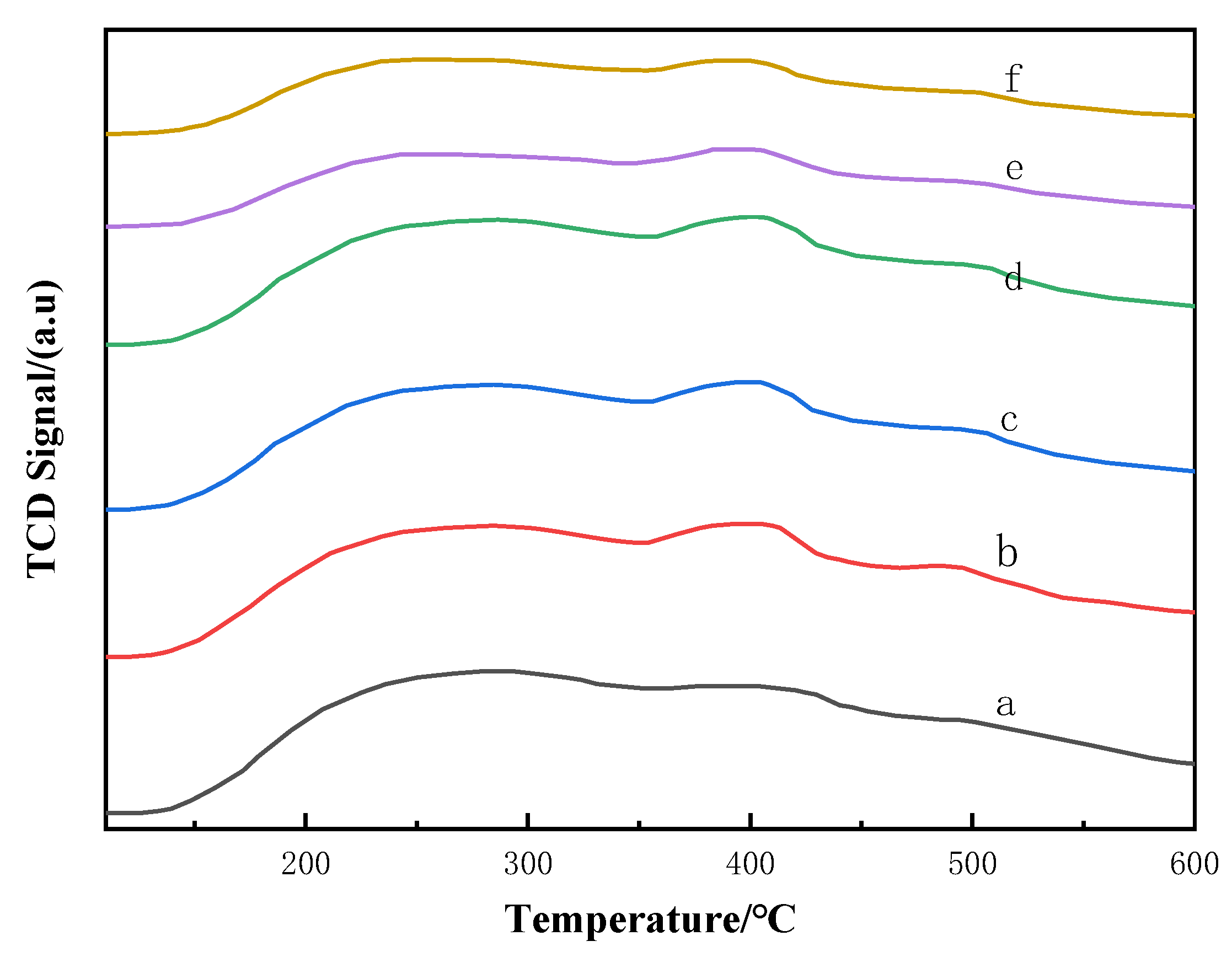
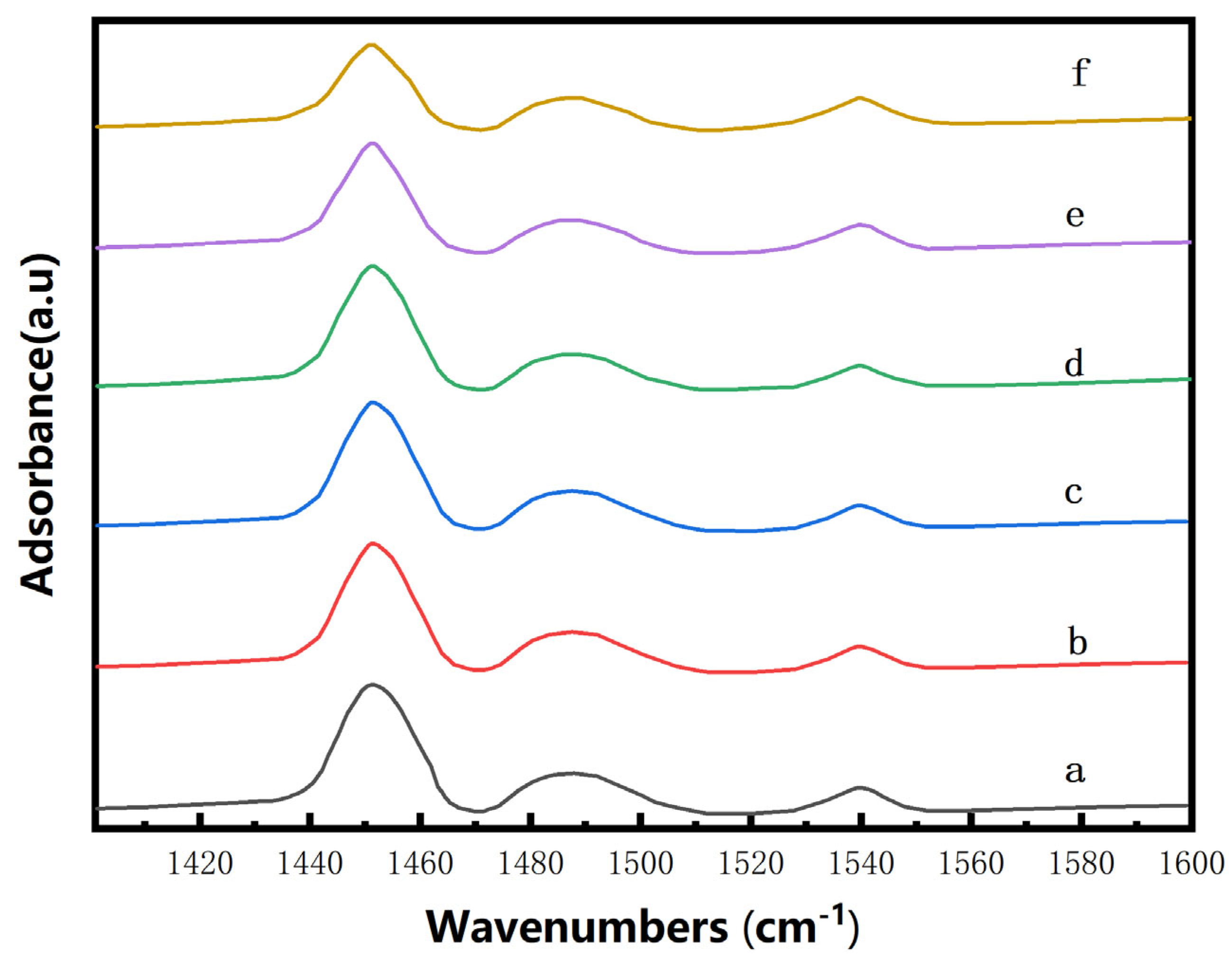

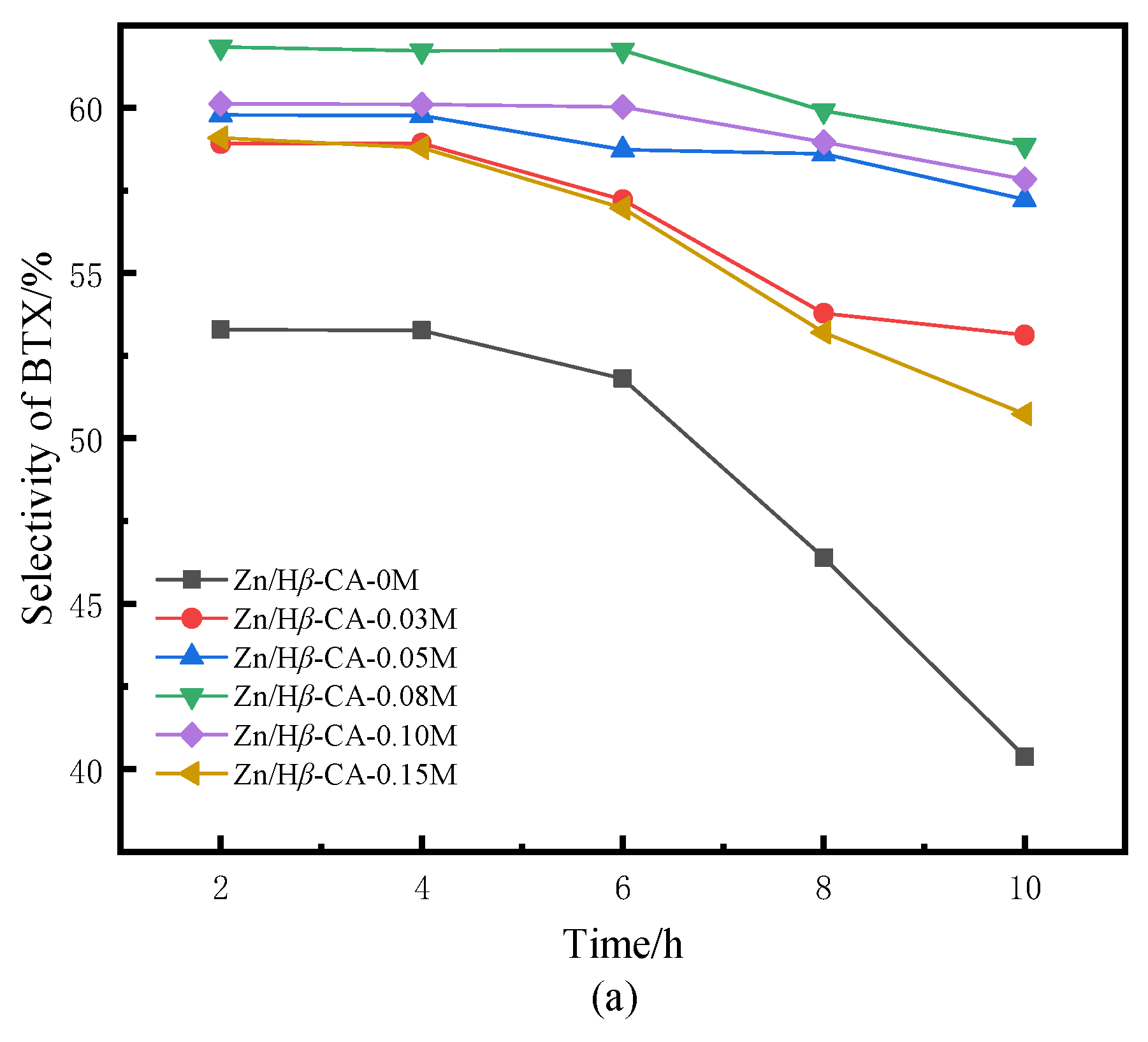


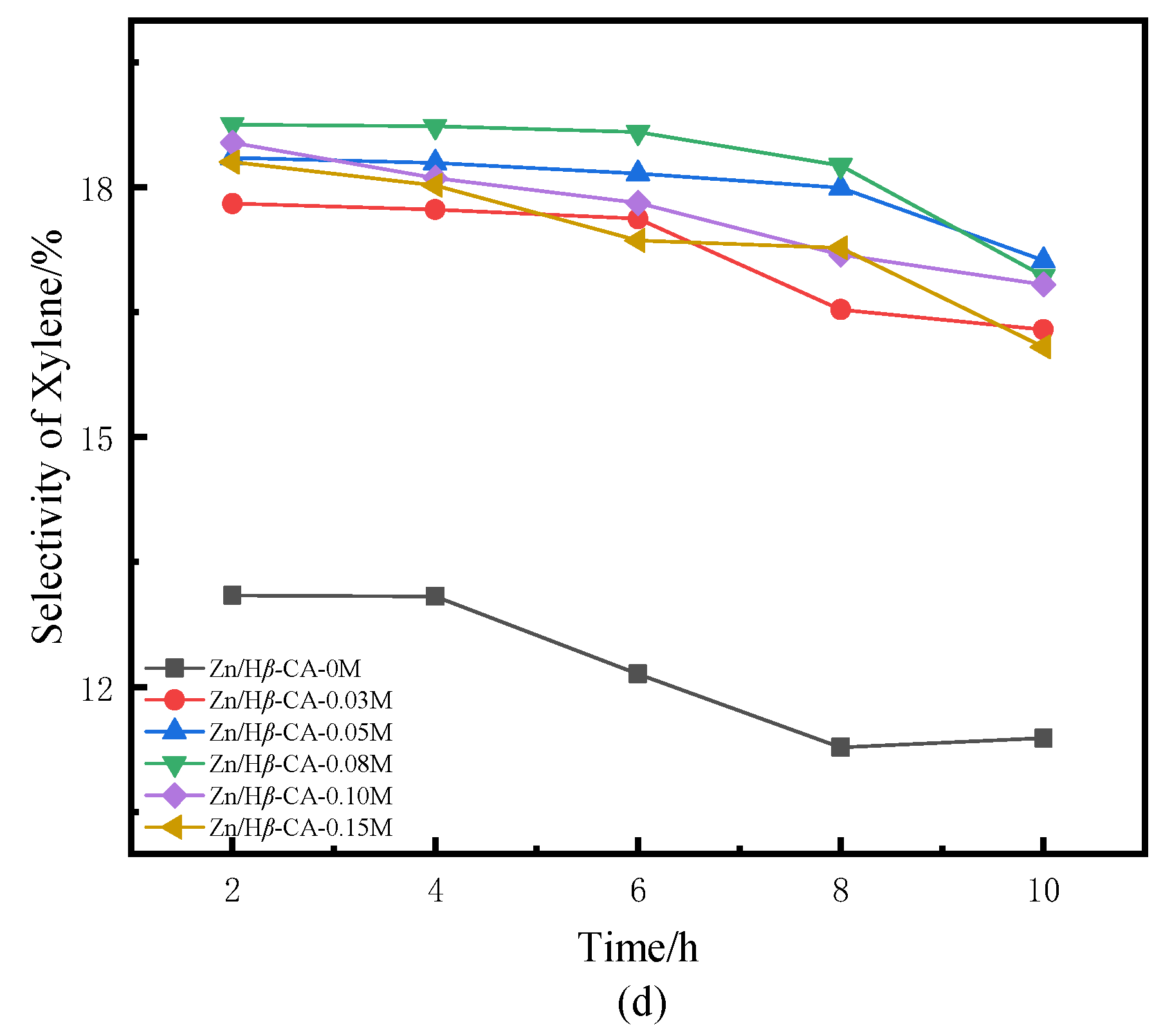
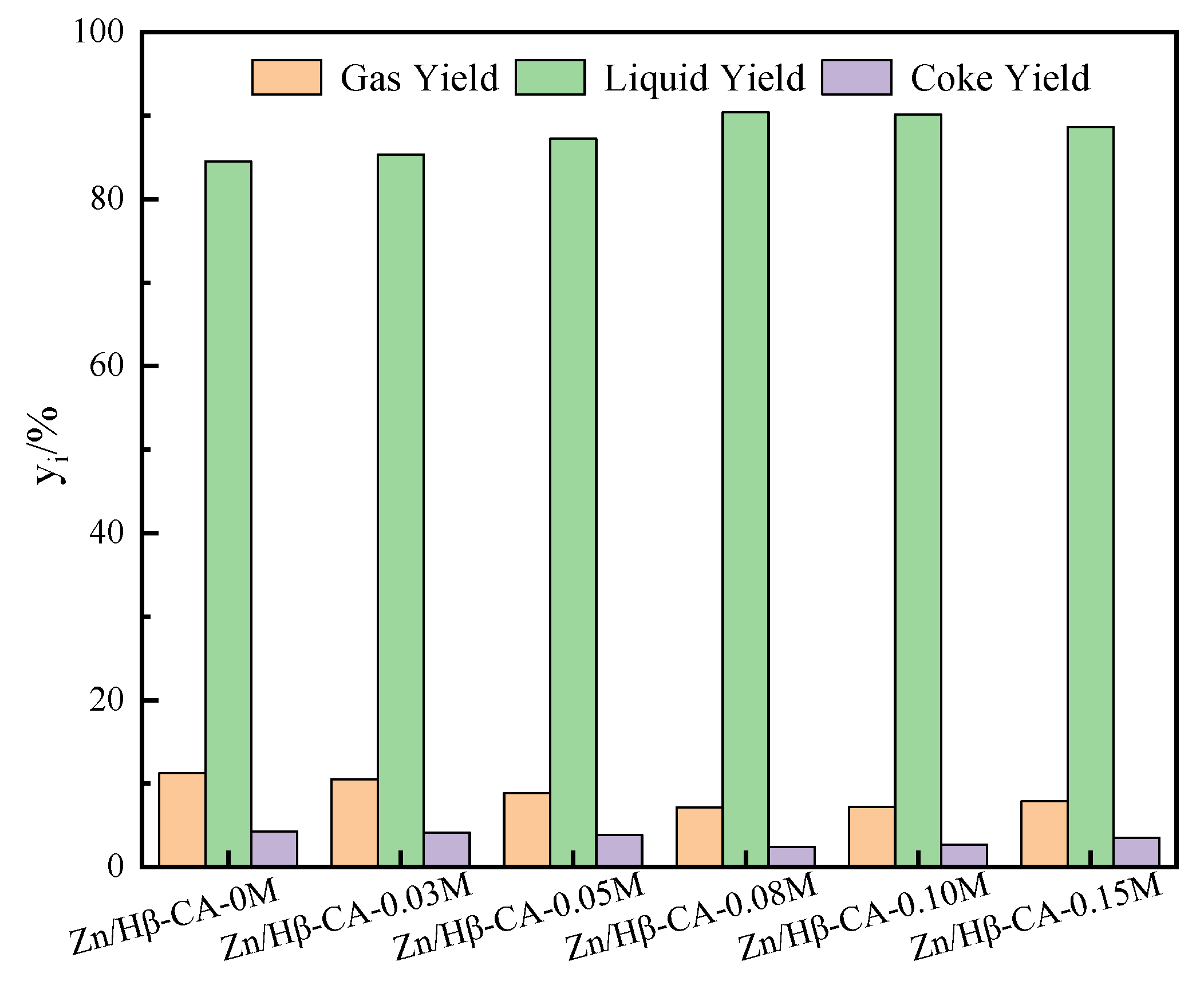
| Sample | Specific Area (m2·g−1) | Pore Volume (mL·g−1) | Pore Size (nm) | ||||
|---|---|---|---|---|---|---|---|
| SBET | Sexter | VTolal | VBJH | Vmicro | Daverage | DBJH | |
| Zn/Hβ-CA-0M | 428.910 | 191.570 | 0.315 | 0.088 | 0.220 | 2.383 | 3.482 |
| Zn/Hβ-CA-0.03M | 437.720 | 155.362 | 0.416 | 0.284 | 0.132 | 3.914 | 7.959 |
| Zn/Hβ-CA-0.05M | 447.790 | 162.092 | 0.438 | 0.291 | 0.139 | 4.098 | 8.189 |
| Zn/Hβ-CA-0.08M | 452.511 | 183.533 | 0.444 | 0.305 | 0.142 | 4.434 | 8.345 |
| Zn/Hβ-CA-0.10M | 423.197 | 173.602 | 0.436 | 0.253 | 0.183 | 4.372 | 7.733 |
| Zn/Hβ-CA-0.15M | 418.123 | 172.585 | 0.428 | 0.248 | 0.180 | 4.187 | 7.725 |
| Sample | L Acid (μmol/g−1) | B Acid (μmol/g−1) | Total Acid (μmol/g−1) | L/B |
|---|---|---|---|---|
| Zn/Hβ-CA-0M | 334.79 | 24.95 | 359.74 | 13.42 |
| Zn/Hβ-CA-0.03M | 333.72 | 24.73 | 358.45 | 13.49 |
| Zn/Hβ-CA-0.05M | 331.98 | 24.39 | 356.37 | 13.61 |
| Zn/Hβ-CA-0.08M | 329.72 | 25.67 | 355.39 | 12.84 |
| Zn/Hβ-CA-0.10M | 297.98 | 25.84 | 323.82 | 11.53 |
| Zn/Hβ-CA-0.15M | 278.67 | 25.97 | 304.64 | 10.73 |
Disclaimer/Publisher’s Note: The statements, opinions and data contained in all publications are solely those of the individual author(s) and contributor(s) and not of MDPI and/or the editor(s). MDPI and/or the editor(s) disclaim responsibility for any injury to people or property resulting from any ideas, methods, instructions or products referred to in the content. |
© 2025 by the authors. Licensee MDPI, Basel, Switzerland. This article is an open access article distributed under the terms and conditions of the Creative Commons Attribution (CC BY) license (https://creativecommons.org/licenses/by/4.0/).
Share and Cite
Shen, Z.; Tang, R.; Liang, S.; Zhang, J.; Li, L.; Zhang, S. Influence of CA-Modified Hβ on Methane-Assisted Hydroconversion of Polycyclic Aromatics to Monocyclic Aromatics. Fuels 2025, 6, 89. https://doi.org/10.3390/fuels6040089
Shen Z, Tang R, Liang S, Zhang J, Li L, Zhang S. Influence of CA-Modified Hβ on Methane-Assisted Hydroconversion of Polycyclic Aromatics to Monocyclic Aromatics. Fuels. 2025; 6(4):89. https://doi.org/10.3390/fuels6040089
Chicago/Turabian StyleShen, Zhibing, Ruiyuan Tang, Shengrong Liang, Juntao Zhang, Leyuan Li, and Shangli Zhang. 2025. "Influence of CA-Modified Hβ on Methane-Assisted Hydroconversion of Polycyclic Aromatics to Monocyclic Aromatics" Fuels 6, no. 4: 89. https://doi.org/10.3390/fuels6040089
APA StyleShen, Z., Tang, R., Liang, S., Zhang, J., Li, L., & Zhang, S. (2025). Influence of CA-Modified Hβ on Methane-Assisted Hydroconversion of Polycyclic Aromatics to Monocyclic Aromatics. Fuels, 6(4), 89. https://doi.org/10.3390/fuels6040089





